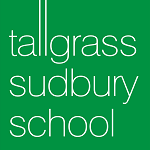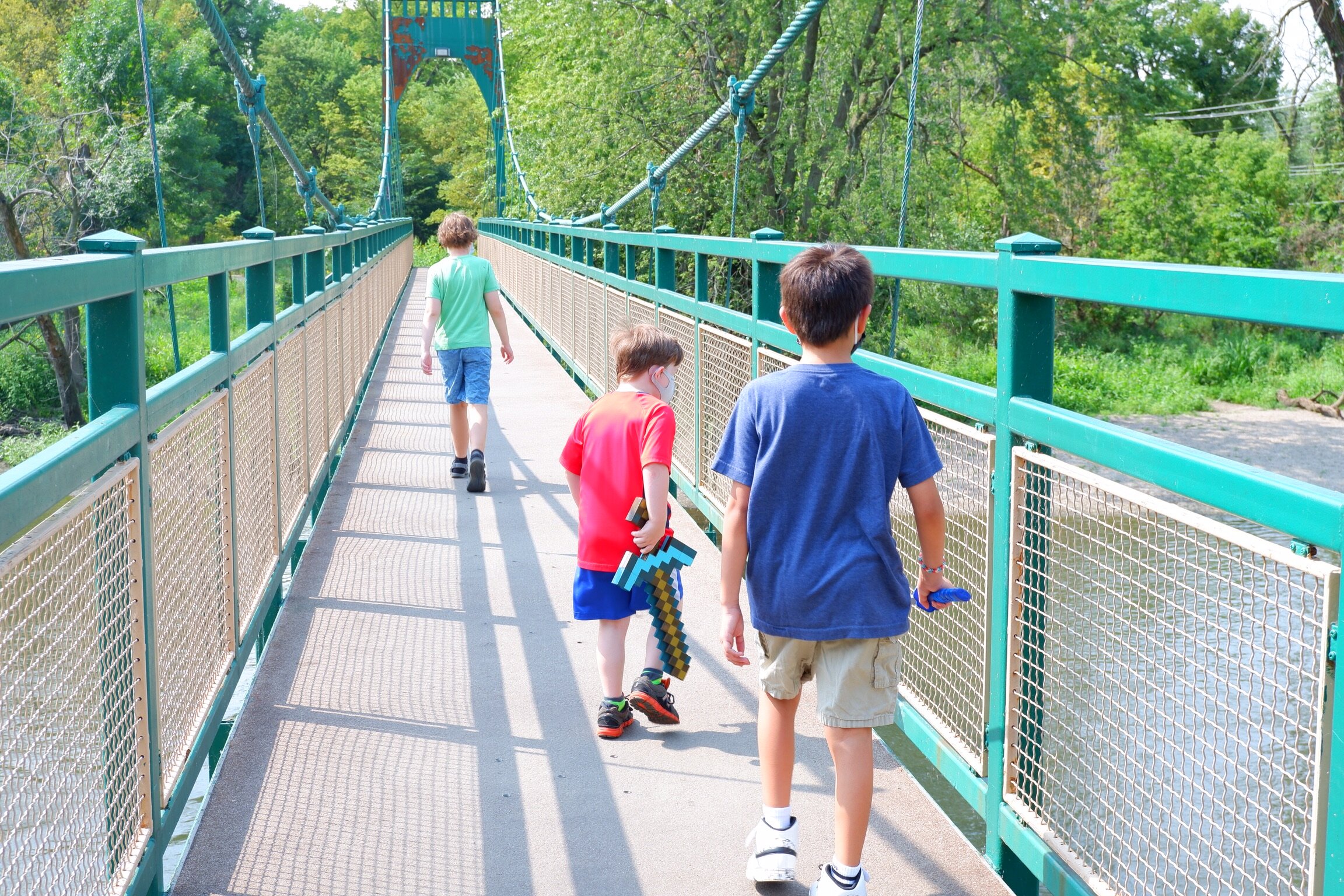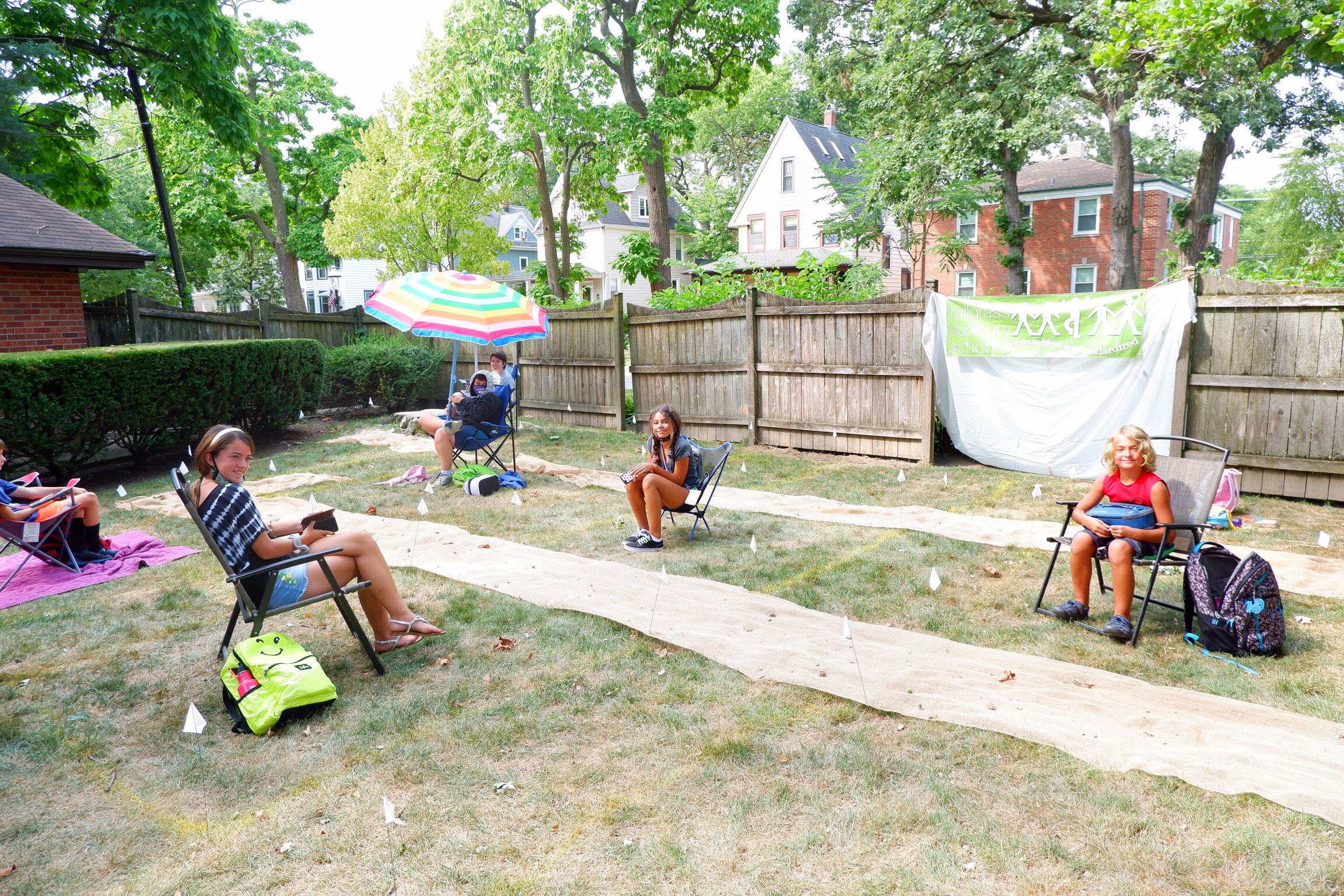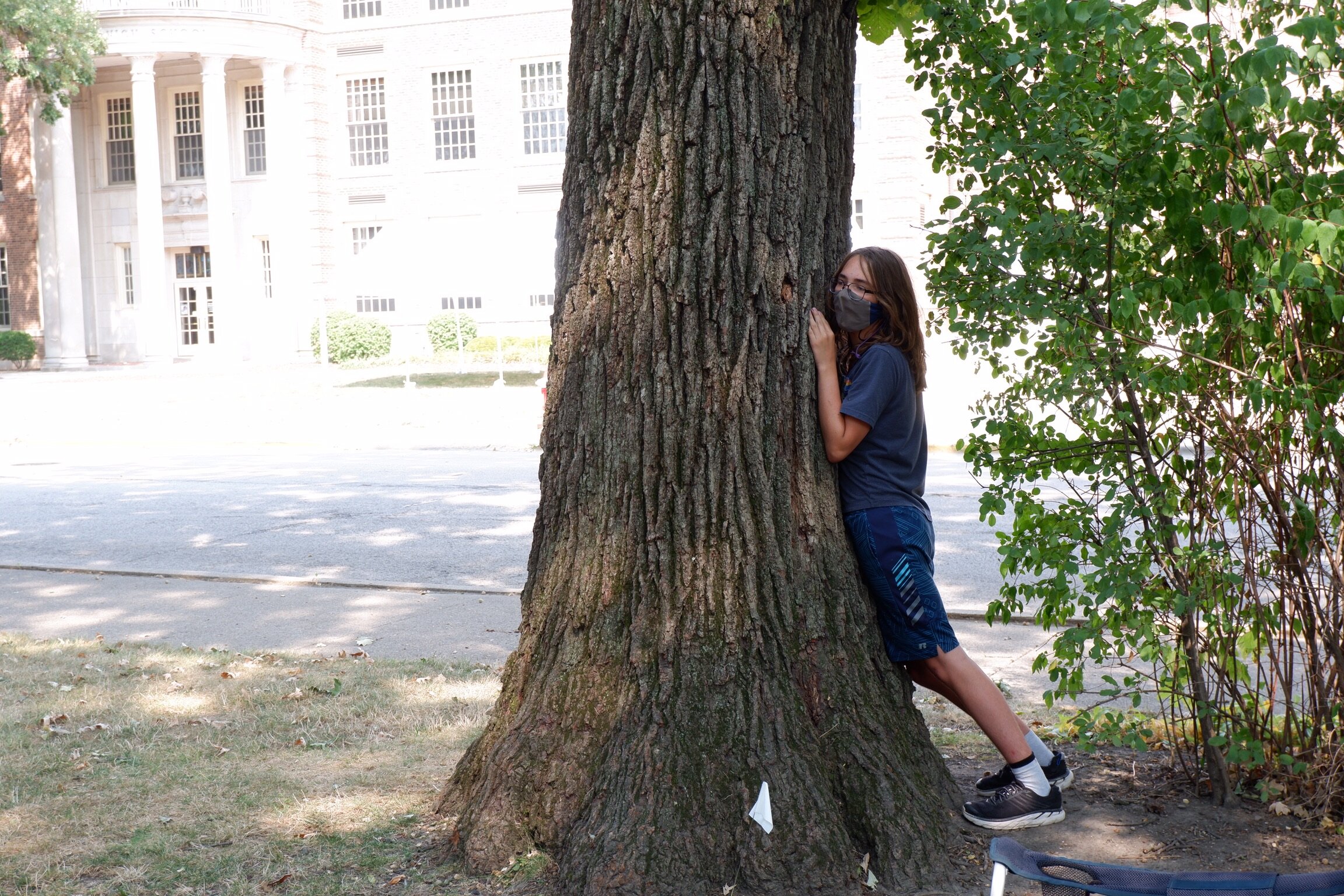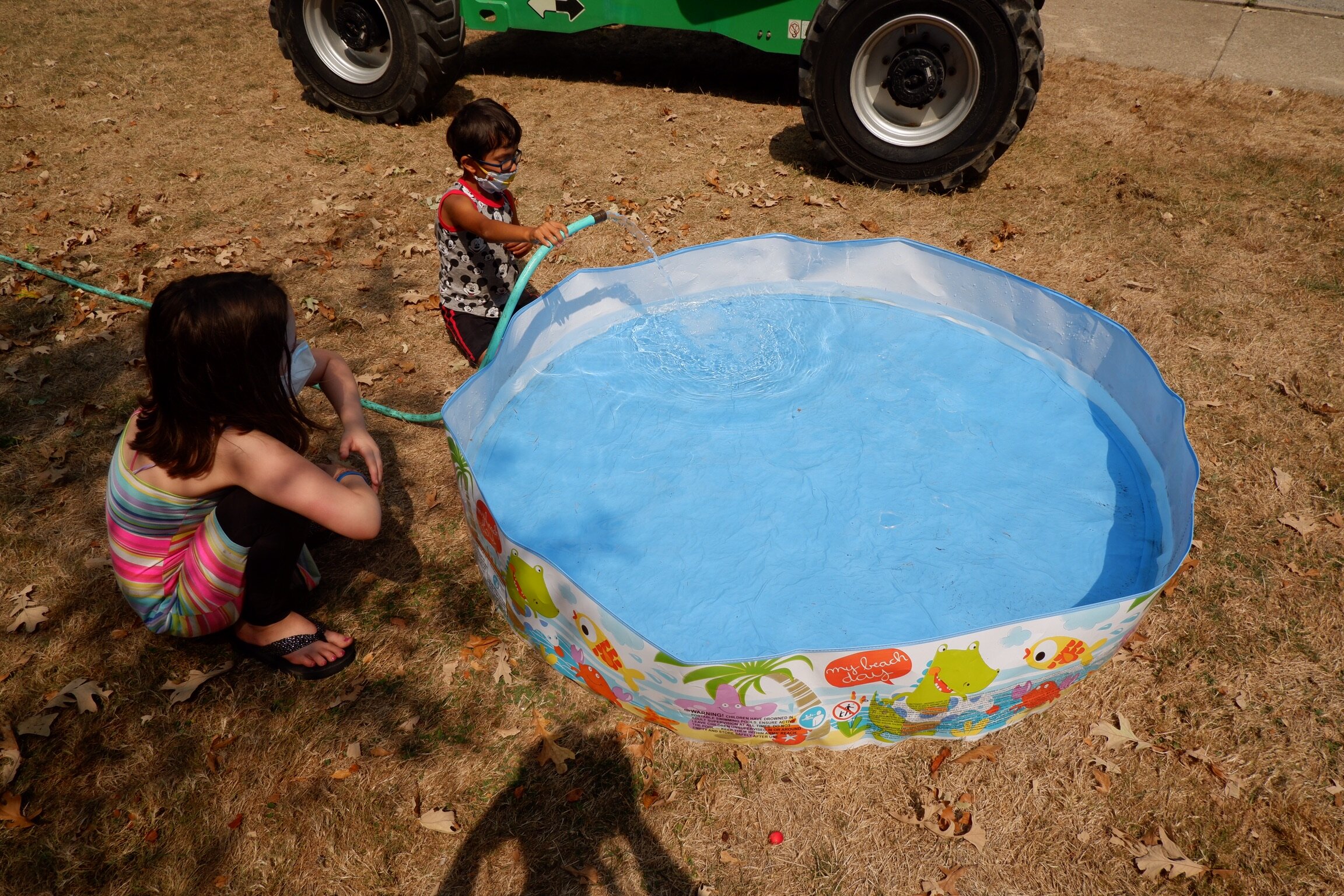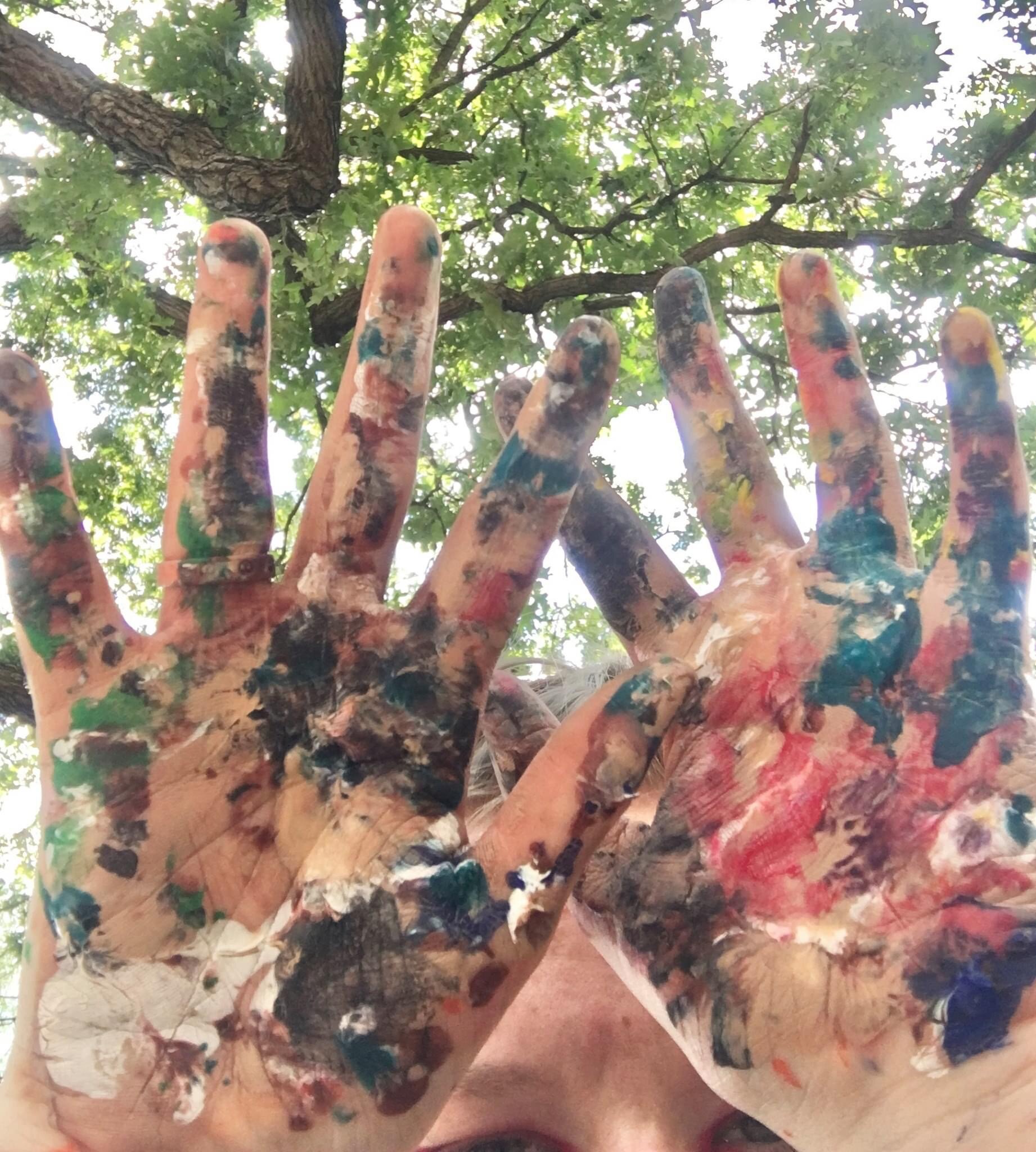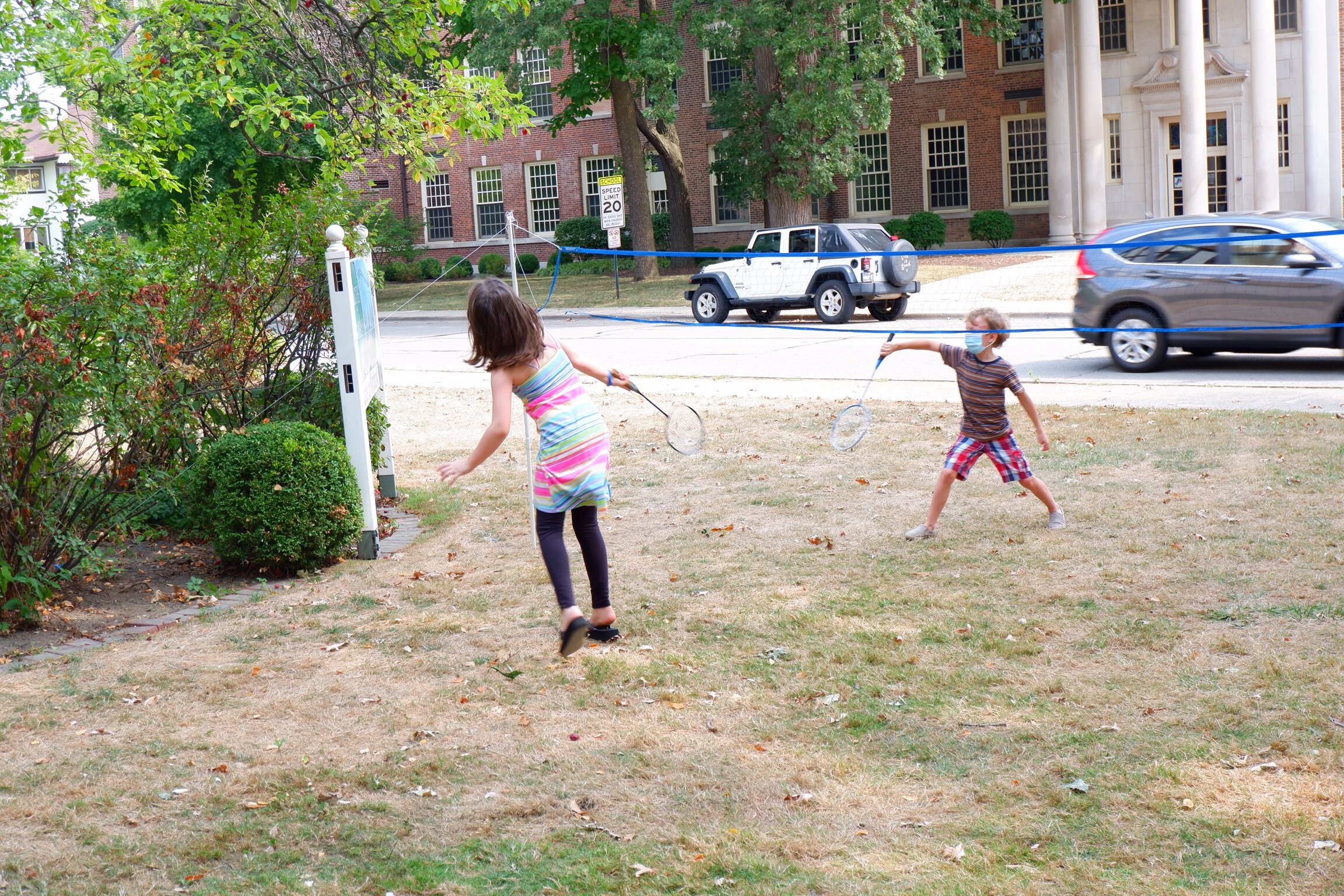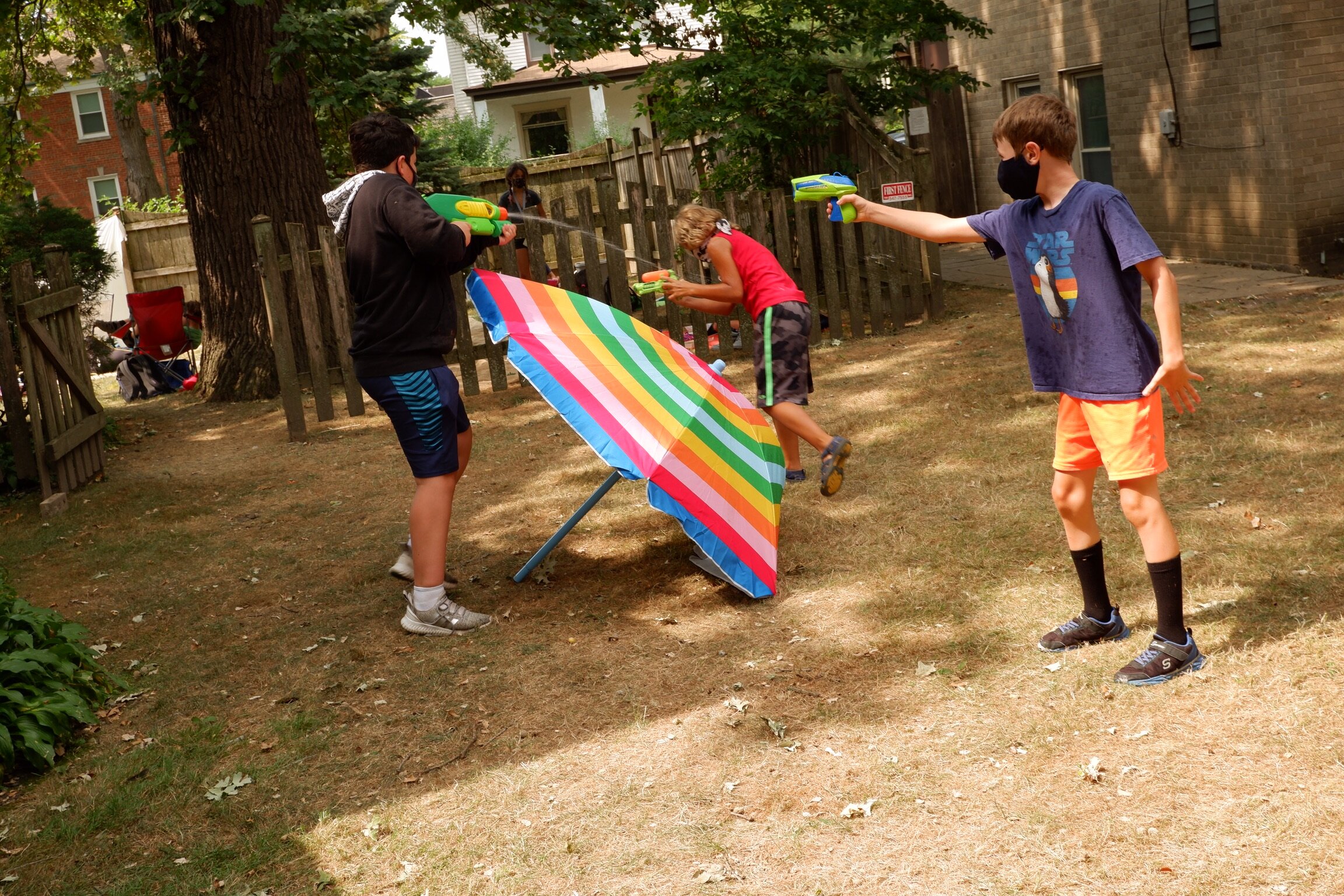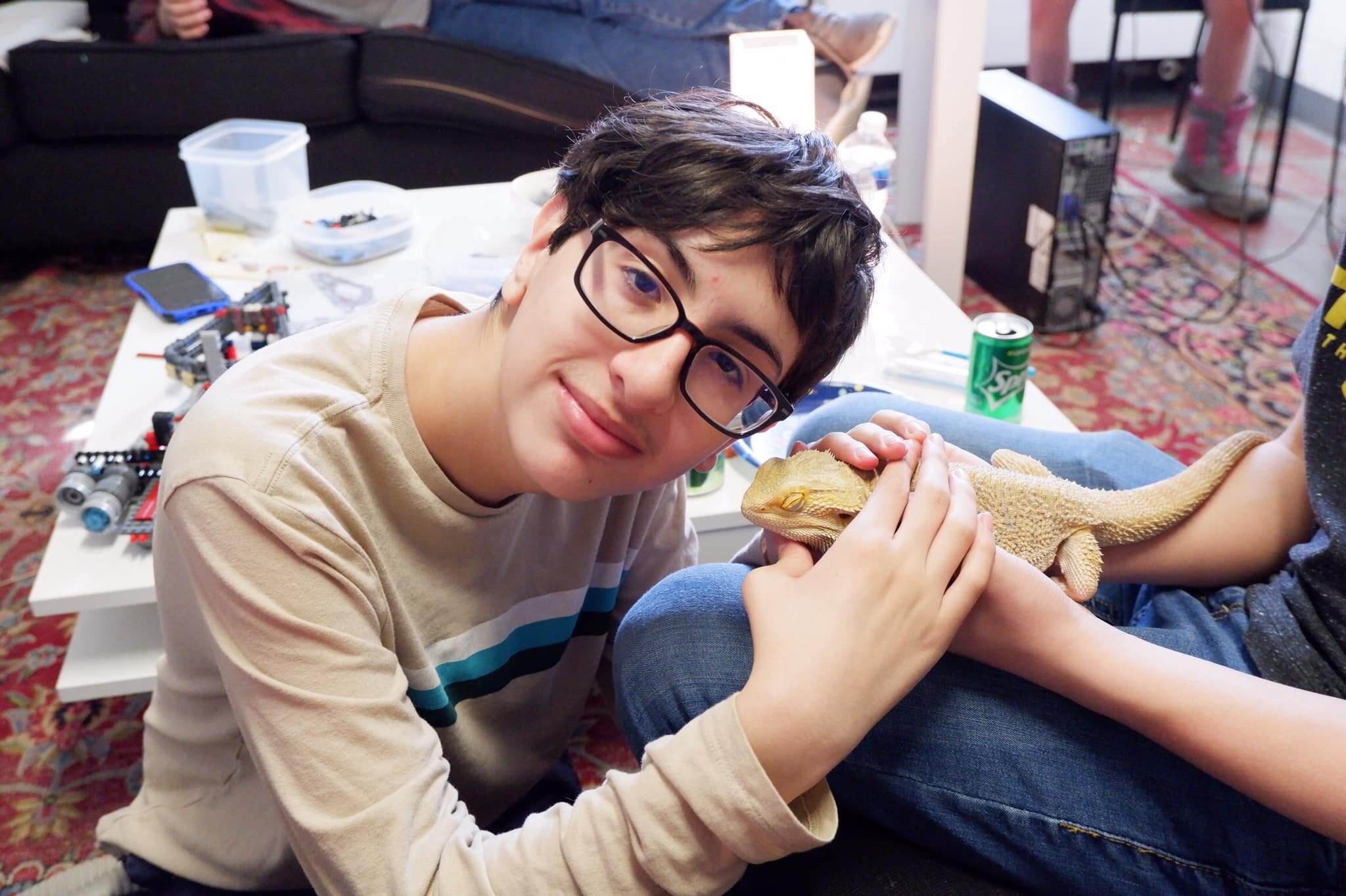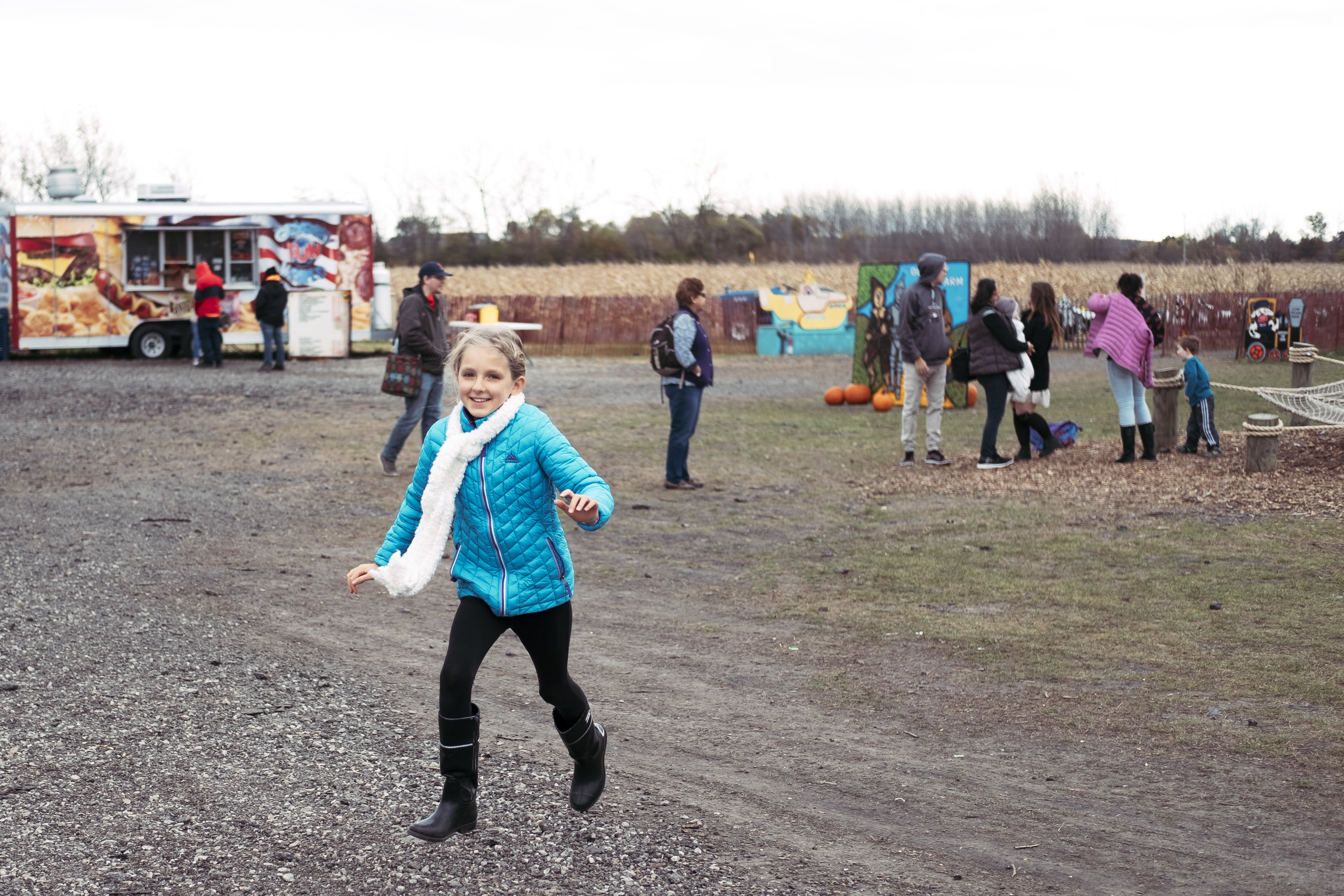We had a wonderful first week back at school with 27 students! It was both different and the same as previous first weeks back at school. As to be expected after a particularly long stint of not seeing each other, the joy and excitement of being together again was stronger than ever. The students showed great adaptability and responsibility by consistently following new safety-related requirements such as morning symptom checks, mask wearing, and completing additional requirements to go on open campus. They even managed to successfully navigate around major building construction and a yard sale that happened to be taking place in the church yard that week. Trips to the park and forest, hide and go seek games, water games, badminton, and art projects were some of the most notable activities that students participated in during the week. On one of the days when we had to meet remotely due to extreme heat, we had a great turnout at our virtual School Meeting with lots of important discussion and motions that were brought up. On both of those days, students found creative ways to direct their own learning from home: setting up a photo shoot with their pet bunnies, watching documentaries about sloths, skateboarding, practicing coding, playing piano with their cats, baking cookies, etc. We can't wait to see all the ways that students continue to direct their own learning during this unique school year!
TALLGRASS SUDBURY SCHOOL COVID-19 REOPENING PLAN
INTRODUCTION
The purpose of this packet is to outline Tallgrass Sudbury School’s policies and changes/adaptations in regards to COVID-19. This document is subject to change. Any changes will be approved by the School Meeting and in consultation with the Board of Directors. Parents will be notified of all changes. Changes are not allowed to conflict with Illinois State Guidelines. We always welcome feedback and conversation from our families and community; please do not hesitate to be in touch with us.
SCHOOL SCHEDULE & ATTENDANCE
A.1 School Calendar
A.1.1 Assuming no unforeseen closures the school calendar will remain unchanged, with the exception of cancelling the Back to School Potluck on the first day of school. All Assembly meetings and other gatherings that take place outside of school hours will happen virtually until further notice.
A.2 School Hours and Attendance Requirements
A.2.1 The school’s full attendance policy, with all changes due to the pandemic highlighted in bold, can be found here, but the main changes are outlined in the following points.
School opens at 9:00 am and closes at 4:00 pm. Students are expected to attend school five hours a day, five days per week on Good Weather Days. Students who cannot meet these requirements due to transportation issues or health concerns related to COVID-19 may elect to perform their self-directed learning at home, either full or part time. This can be achieved by school meeting approval. Taking part in self-directed learning at home, an off-campus educational activity, or a field trip that is school meeting approved is considered attending school.
Students must sign in and out with either a staff member or the attendance clerk on Good Weather Days. On Bad Weather Days or in the case that a school day must take place remotely for reasons other than weather, students can meet attendance requirements by 1. attending a School Meeting, 2. by participating in a school organized group activity via Zoom, or 3. by spending time on an activity that has been chosen from a school generated list or that they came up with on their own. If the 3rd option is chosen, students must report what activity they did by the end of the day (4:00 pm) to the Attendance Clerk or share it at the end-of-the-day group check in.
Absences caused by illness (including any symptoms, treatment, or quarantine due to COVID-19) or transportation problems that are communicated to the school by the student or parent by 11:00 a.m. are excused.
WEATHER AND REMOTE LEARNING
B.1 Good Weather Days vs Bad Weather Days
B.1.1 Tallgrass will meet in person outdoors whenever possible, but we must also plan for days when that is not possible due poor weather. For this reason, we have created two different weather categories:
Good Weather Day: A day in which the weather is expected to be safe and tolerable for the vast majority of students and staff.
Bad Weather Day: A day in which the weather is expected to be unsafe and/or intolerable for the vast majority of students and staff.
B.1.2 Staff will check the weather forecast daily and if a Bad Weather Day is expected for the following day, families will be alerted by 7pm and school will take place remotely the following day.
B.2 Unexpected Extreme Weather
B.2.1 In the case of unexpected extreme weather during a school day when we are meeting in person, staff and students will seek shelter inside and stay cautiously distanced from each other until it is possible to return outside or until they leave for the day. If the extreme weather is expected to continue for more than an hour, staff will contact parents for student pick-up.
B.3 Remote Learning
B.3.1 Remote learning will take place on Bad Weather Days or if otherwise necessary due to state mandates or other health concerns related to COVID-19.
B.3.2 On Bad Weather Days or in the case that a school day must take place remotely for reasons other than weather, students can meet attendance requirements by doing at least one of the following 3 things:
1. Attend a School Meeting
2. Participate in a school scheduled group activity via Zoom
3. Do at least one activity that has been chosen from this school generated list or that they have come up with on their own. These activities can be anything that the student believes contributes to their education and/or well being. If the 3rd option is chosen, students or parents must report what they did by filling out this form by the end of the day (4:00 pm) or by sharing it at the end-of-the-day group check in.
B.3.3 The schedule on Bad Weather or Remote Learning Days will be:
Mondays or Wednesdays:
11:00 School Meeting
2:00-3:30 End-of-the-day group check in - This will be an opportunity for students to share how they are doing and what they did that day.
Students can also add additional activities of their choice to the schedule by filling out this form.
Tuesdays, Thursdays, or Fridays:
12:30-2:00 Group Activity - These will be planned by the staff based on feedback from students about what they are interested in doing.
2:00-3:00 End-of-the-day group check in - This will be an opportunity for students to share how they are doing and what they did that day.
Students can also add additional activities of their choice to the schedule by filling out this form.
B3.4 We have created a Tallgrass Bitmoji Virtual Classroom where families can access the schedule on remote learning days as well as links to Zoom meetings and important forms. Staff will send out a classroom with a generic schedule, which will be updated and sent out to families whenever we are meeting remotely. Click on different objects in the room to access different things.
HEALTH AND SAFETY & ENFORCEMENT
C.1 Masks
C.1.1 Cloth face coverings or surgical masks must be worn at all times except while eating or in a socially distanced area that is designated by staff. These designated areas will be referred to as “bases.” Each person’s base will be identified with something like a blanket/towel/yoga mat/etc. and/or some form of marking on the grass.
C.1.2 Every individual on the school campus must carry a mask with them at all times.
C.1.3 Masks will be provided to any School Meeting Member who does not bring a personal mask to school.
C.1.4 Masks must be properly worn, according to CDC guidelines.
C.2 Social Distancing
C.2.1 Physical distancing of 6 ft. is required at all times, except in the case of people living in the same household or in the case of an emergency.
C.3 Screenings
C.3.1 Families are required to monitor for COVID symptoms daily before sending their child/children to school. If your child tests positive for COVID-19, or has had contact with someone who tests positive for COVID-19, please contact the school immediately.
C.3.2 If a student, staff member, or visitor from the school tests positive for COVID-19, or has had contact with someone who tests positive for COVID-19, we will follow the Department of Health's recommendations on the specific situation and level of contact that the person had. At minimum, they and anyone they had close contact with must self-quarantine for 14 days. Students who are self-quarantining but are well enough to participate can use the school’s remote learning guidelines to continue their learning at home.
C.3.3 In addition to daily family symptom checks, all students, staff, and visitors are required to do a temperature and symptom check upon arriving at school each day. Once students arrive at school, a staff member will take their temperature with a no-contact thermometer. There will be a check-in station set up near the entrance of the school where this will take place. If one student arrives around the same time as another student, the student who arrived later will be asked to wait in their car or in a socially distanced area nearby until the other student is finished checking in. Parents dropping off their students are highly encouraged to stay, but wait in their cars until their child has completed the temperature and symptom check.
C.3.4 Anyone who has a temperature above 100 degrees F or who exhibit any other symptoms that could be COVID-19 (which include, among other symptoms, cough, and chills) must stay home, or, if symptoms develop at school, must be quarantined inside and supervised until they can be picked up.
C.3.5 The cleaning of the quarantine room post a suspected or confirmed case will follow CDC guidelines.
C.4 Sanitizing Stations and Handwashing
C.4.1 Sanitizing stations will be set up around campus. Each station will include hand sanitizer and disinfectant wipes. There will also be at least one handwashing station set up outside with water, soap, paper towels, and a garbage can.
C.4.2 Individuals are required to clean their hands upon arriving at school, after using the bathroom, before and after eating, after blowing their nose, or after coughing into their hand.
C.5 Building and Material Cleaning
C.5.1 Individuals who use the tables outside are required to wipe them down with a disinfectant wipe after each use.
C.5.2 Bathrooms will be cleaned by staff or other designated adults with disinfectant daily or more often if deemed necessary.
C.5.3 School Meeting Members are still responsible for immediately cleaning up their items and any messes made.
C.5.4 Instead of signing up for and doing chores, students will participate in daily yard cleaning, which will be managed by the Chore Clerk.
C.6 Enforcement
C.6.1 Enforcement of these policies will be handled by JC. However, any combination of 2 staff members or JC Clerks reserve the right to send anyone home immediately until the next JC or School Meeting for non-compliance. Whenever possible, staff and JC Clerks will give two verbal warnings per day before sending anyone home.
C.6.2 The following laws have been added to the lawbook:
Masks must be worn at all times except while eating or in an area that is designated by staff that is also socially distanced from other people.
Physical distancing of 6 ft. is required at all times, except in the case of people living in the same household or in the case of an emergency.
Individuals are required to clean their hands upon arriving at school, after using the bathroom, before and after eating, after blowing their nose, or after coughing into their hand.
Sharing of objects should be kept to a minimum and if necessary, both objects and hands should be sanitized immediately after.
Anyone who has symptoms that could be COVID-19 (which include, among other symptoms, cough, fever, and chills) must stay home, or, if symptoms develop at school, must be quarantined inside and supervised until they can be picked up. All students and staff are required to do a temperature and symptom check upon arriving at school each day.
C.6.3 Open Campus can continue as normal. Students who are certified past the yard must complete the following additional requirements related to COVID-19 safety before they can leave the yard:
When is it ok to take your mask off? A- Only while eating or in an area that is designated by staff that is also socially distanced from other people.
All students and staff need to maintain social distancing at all times. What does this mean? A- Everyone needs to stay at least 6 ft. apart at all times, except in the case of people living in the same household or in the case of an emergency.
Acknowledge that, when possible, you will sanitize your hands regularly on open campus and that if you, or anyone you are with on open campus shows symptoms that could be COVID-19 (which include, among other symptoms, cough, fever, and chills), you will return to school and inform a staff member immediately.
SOCIAL AND EMOTIONAL WELL BEING
D.1 Social and Emotional Well Being
D.1.1 We recognize that the pandemic has caused stress for many of our students and that while transitioning back to school will be a welcome change from being quarantined it will also come with difficulties. We all miss our normal lives and look forward to the days where students can pile on the couches, share toys, food, and hugs. Until this time comes we will do everything we can to be sensitive to their struggles and to create a safe and joyful environment with as little fear as possible.
D.1.2 Staff will be available for mental health check-ins with students. These can be scheduled directly with a staff member or by filling out a check-in request form at school. On remote learning days, staff will have scheduled “office hours” during which students can sign on and talk with staff.
CAMPUS IMPROVEMENTS AND CHANGES
E.1 Outdoor Spaces
E.1.1 There are two main areas within our outdoor space.
Base Zones: Bases are 6ft x 6ft squares that are marked on the grass in the yard. When students arrive, they can claim a base for the day. Only one person is allowed on a base at a time and this is the only place where masks can be taken off (unless someone is eating or drinking). Most of the bases are located in the fenced-in part of the yard, but there are also a few on the far end of the main yard. All bases must be cleared at the end of the day. Personal items can be taken home or left in personal storage containers which will be stored in the school building overnight. This is also the area where School Meetings will generally take place.
Activity Zones: These are areas in the yard where bases are not set up. Tables will be set up here where people can eat or do other activities that require a flat surface. There will be resources available for students such as sport equipment, water games, and other supplies that can be sanitized between users or restricted to one individual.
E.2 Indoor Spaces
E.2.1 Except in the case of emergencies, only 2 students are allowed in the building at a time for the purpose of using the bathroom or for retrieving or putting away personal items in the basement. When someone needs to use the bathroom, they can write their name on the white board before they go up, and erase it when they come back down. Anyone going into the basement storage room should check before entering to make sure there is no more than one person inside.
SUPPLY LIST
At least two facemasks
A towel/blanket/yoga mat or something similar to use as a “base” during the day. Lawn chairs are also welcomed.
A water bottle marked with the student’s name
A lunch that does not need a fridge or microwave, also marked with the student’s name
Appropriate clothing and shoes for a variety of outdoor activities and weather, including a rain jacket, poncho, or umbrella
Sunscreen
Bug spray
A change of pants and shoes, especially for younger children
A Rubbermaid or similar weather proof and sealable container to store personal items such as a backpack, lunch, or other personal items in. These containers will be used in place of cubbies and will be stored under the tent outside during school day, and will be brought inside at the end of each day.
(Optional) Battery operated hand held fan/spray bottle for hot days
Fall 2020 Outdoor Learning
Tallgrass Sudbury School will start our year outdoors, using the yard attached to our school as well as other nearby outdoor spaces, such as parks, the forest preserve, and the outdoor portions of the Brookfield Zoo. Our indoor space will be accessible for restrooms, water, first aid, and other necessities. On days with truly inclement weather, we will move to remote learning for the day.
We’ve chosen this plan to maximize safety while also acknowledging the strong need of kids and teenagers to be together in person. Our program will follow all state safety guidelines surrounding the COVID-19 crisis. Masks will not be required while outdoors, but will be required during any time spent indoors, and the school reserves the right to require masks outdoors if social distancing is not possible or in other specific situations.
Rediscover joy with us this fall, and enjoy the gorgeous Riverside area and our community-based, self-directed approach. Contact us for more details and to enroll for this month-to-month opportunity, available to students ages 5-18. Email info@tallgrasssudbury.org or text us at
Attend our online information session on Saturday, August 15. RSVP on Eventbrite for the link to attend the session.
Self-Directed Learning in the Time of COVID-19
(Since drafting this post, I’ve come across a couple of other good pieces on similar topics: this article by Maleka Diggs and this one by Kenneth Danford.)
With the rapid changes in how “school” works, and the transition of almost the entire world to remote learning, many students have more access to self-directed learning than they did before. But self-directed education, unschooling, and democratic education also look very different than they did a month ago.
Tallgrass Sudbury School, like many others, has scrambled in the past few weeks to create a remote learning experience for our students. Zoom calls and online chats are no substitute for the community we usually experience in person. We have to put more effort into pre-planning, our options are more limited, and the beautiful spontaneity that is usually present at our school is much harder to access online.
Let me be clear: This is not a good time to truly start self-directed learning, and it’s not an ideal time to deschool, either. Self-directed education usually involves plenty of time away from home, lots of time connecting with others in person, and taking full advantage of a wide range of opportunities. In our old normal, there were countless factors encouraging all of us to engage more with the outside world. Those things aren’t present in the same way right now. With the underlying stress and uncertainty that everyone is experiencing, it’s harder to engage and we may not get the same satisfaction from it that we usually would. We may be more prone to depression and to spending a lot of time on activities that provide easy distraction.
A few days before school went online, we celebrated the First Annual Bring Your Reptile to School Day. One of the silver linings of remote learning is seeing pets on video calls—including ones that couldn’t possibly come to school, like fish and backyard chickens.
Nonetheless, it’s a unique opportunity for people who are currently enrolled in school to have a different relationship with freedom than they usually do. Schools are dialing way back on evaluation and grading, canceling standardized tests, easing “attendance” requirements, and phrasing many of their remote learning plans as suggestions instead of mandates. While most schools are still at heart non-consensual learning environments, there is suddenly much more room for elements of consent to be present and for students to liberate themselves. For students who haven’t yet made the leap into fully self-directed learning, this may be an opportunity to take more control of their education.
If you’re interested in exploring self-directed education right now, but your children are still enrolled in a conventional public or private school, here are some ways to shift your orientation more towards self-directed learning.
Use the leeway the school is giving you right now. Many remote learning plans are phrased as “suggestions” because of very real digital and economic inequalities. Let your child opt out of things that are optional. Let them ignore the suggestions and ditch the school’s online portal for virtual play dates with their friends, or let them spend 3 hours in the art portal and no time at all in the English one.
Reconsidering “screen time” is more important than ever. Try to let go of your preconceptions of how much time kids “should” spend on screens or the effects of screens, and pay more attention to the day-to-day realities. For many kids, online interaction is now the only way they can connect with their friends. For many kids (and adults), online activities are one of the main ways they can find things to focus on and to be genuinely engaged with. Let them do the things that make them happy and allow them to engage or connect with others, whether that means Khan Academy or TikTok. And remember we all need some distractions and “zoning out” time right now.
It’s also important for all of us to have offline time--for instance, I’m learning that I max out on video calls after a few hours. It’s okay to have boundaries that are genuinely rooted in their needs or yours--a turn off time at night, no phones at the dinner table (as long as that includes adults!) and boundaries around what you will or won’t do for them while they’re gaming (i.e., you need to get your own snacks, or I’ll read the directions for you until 10:00, but then you need to read them on your own). Boundaries for kids around “screen time” should be similar to the ones you would have for yourself or other adults.
Redefine what you think of as “learning.” Learning is life, not just academics. Your children are learning when you talk together, when you take a walk, and when they spend all night watching YouTube. They are learning when you bake bread together--and that doesn’t mean you need to talk ostentatiously about fractions and how yeast is a microorganism. They are learning even without that. Just live together. Talk normally. Support each other. Let them help and let them support you. Humans are made to learn--so let them.
When creating schedules, listen to what your kids want and need. Let them have genuine input on how the family is organizing its time and what you’re doing together and apart.
Don’t use any “failure” during this time as a measure of whether self-directed learning is a good option for your family. We are all under an immense amount of stress and dealing with an unprecedented number of rapid changes. There are too many limitations, and too little idea of what our “new normal” is going to be. If exploring self-directed education goes badly right now, try it again later.
Now more than ever, it’s clear that we’re making this up as we go along. And that’s okay. That’s always been true. All we can do is keep loving each other, and doing the next right thing.
Scholarship Alert!
The current moment has many of us reevaluating our lives, including how we approach education. Tallgrass Sudbury School is pleased to announce that we are offering two full-tuition scholarships, each for 4 years of tuition-free enrollment at Tallgrass, starting in fall 2020.
Tallgrass is committed to making our school accessible to all families regardless of their financial situation. We dedicate 60% of our income to financial aid, using a sliding scale for tuition. But we understand that paying anything for tuition is still a hurdle for some. We hope that these scholarships will make our school accessible to students who might not otherwise be able to consider Tallgrass.
At Tallgrass, students direct their own learning, pursuing their goals in the ways that make sense to them while contributing to a strong, democratically run community. Tom, a graduate who went to public school before coming to Tallgrass, said this about his schooling experience: “At my previous high school I was stressed out all the time. When I came to Tallgrass, I stopped feeling stressed and now I’m able to focus on what matters to me.” By offering this new full scholarship program, we hope that more students like Tom will now have access to this educational option.
To apply, prospective applicants must complete an initial call with our admissions director and an enrollment interview by May 15, via phone or video conference. Applicants do not need to submit financial aid applications, but should announce their intent to apply for the scholarship during the enrollment interview. Scholarship recipients will be chosen by lottery and notified by June 1. The scholarship is open to students 4 through 18 who are not already enrolled at Tallgrass.
To apply or get more information about the lottery program or our school, please contact us at info@tallgrasssudbury.org.
To All the Self-Directed Young People Experiencing Self-Doubt: I Believe in You
Let me start with the basics.
You can go to college
or be a bird photographer
or go to Japan
or be a gymnastics coach
now
or in 2 years
or in 5 years
or not at all.
You can go to UIC
or Triton
or Soka University
or almost any of the 5,000 other colleges in the US
or you can live on a houseboat
or have babies
or fur babies
or be a Stoic Marxist living in a studio apartment.
Why?
Because we tell kids lies.
You don’t need to sit in a classroom for 16--17--18 years, learning the things someone else says are important (who? the Texan legislature? A teacher you don’t even like?) and jump through all the hoops, to earn the life you want.
Take what works for you, if any of it does. Leave the rest.
You are not less because you are young.
You only have one life.
Ask the adults. They did it. Do they think it was worth it?
I’m not going to say it’s easy.
Sometimes it’s easier to do the expected thing. Sometimes it makes more sense.
But you don’t have to suffer every day for years to earn a decent job and a decent life.
If you like it, ok.
If it’s working for you or you love your football team or something...great.
(I still think you should be able to use the bathroom when you want to.)
But if you don’t…
You are not damaged.
You are not dumb.
You did not mess up.
You are having a normal reaction to a system that is not made for humans. It is made to rank people, so that employers and colleges can judge people more easily, and to babysit you and keep you out of the labor force.
It is made so only a few people can “succeed.” (Not everyone can be above average.) It’s made to make people work more like machines.
You’re not wrong. The system is wrong.
Just because some people like it doesn’t mean you’re broken.
Just because your brother does ok doesn’t mean you’re broken.
Just because you know 3 dozen awesome, caring teachers and one of them is your mom doesn’t mean you’re broken.
You’re enough.
You were born enough.
You will struggle and make mistakes and have to work on your weaknesses and learn many, many things. There will be hard days and hard years.
And none of that means you are broken.
Broken is a lie.
The truth is:
You can choose.
You can choose which credentials are important to you.
It is a lie that you need to go to middle school to go to high school, to go to high school to go to college, that you need to do all these things, one way, in order, to be a successful or good or happy person.
That is because it’s all based on a lie. A fundamental lie about how people learn, and how they have learned for millions of years.
You don’t need school to make you worthy of your life.
You need support. You need community. You need help.
But you don’t need someone to tell you who you are. You don’t always need a teacher. You are always learning. You can’t even help it.
No one else can tell you who you are even if you want them to.
No one has all the answers.
No one can guarantee your success or happiness.
You are the best judge of what you need.
You are the best judge of what you need to learn
and how you spend your time
and what kind of person you want to be.
I believe in you.
I know you can do it.
Achievement comes in many shapes.
The 2016-2017 Tallgrass prom
February Open House
Monday, February 24th
6:30-8:00 pm
Tallgrass Sudbury School
82 Woodside Rd.
Riverside, IL 60456
Learn more about the benefits of a Tallgrass education, get a tour, and talk with the school's staff, students, and current parents! This event is free and open to the public.
How Becoming A Sudbury Family Saved Our Son
Elizabeth C. Mishler, parent of Paul, 12
I grew up with phrases like “Free to be You and me,” “Question Authority,” “Let It All Hang Out,” and “Power to the People.” “Subvert the dominant paradigm” became a mantra of mine. In fact, all of these slogans require a person to be aware of themselves in the world, to be aware of other people around them, and to be consciously cognizant of the effects they have on others and on the environment.
Fast forward to 2007, when my son Paul was born. Suddenly subverting the dominant paradigm required a lot more commitment and conviction, and the stakes were a whole lot higher. Deciding what school your child will attend is a very big deal. In Chicago, especially, it is a colossally big deal. We braved the bureaucracy, visited every school we were aware of, subjected our son to the absurd selective enrollment tests, and ultimately settled on the dual-language program of a progressive nonprofit charter school.
Paul attended this school for 5 years. He benefited from the school’s commitment to organic meals and the curricular focus on global awareness, sustainability, and environmental stewardship. But something happened. Along the way our son was bullied and made to feel like an outsider. He had friends at the school, but in general was very unhappy. After 4th grade, we were very concerned about his return to that school’s environment and to an unfriendly and ineffective teacher.
One of the school’s administrators, a well-qualified, loving, progressive individual, recommended Tallgrass. We had not heard of Tallgrass before and, other than the Brookfield Zoo, had very little knowledge of the Riverside area. The principal described an innovative, mixed-age school where learning is self-initiated and self-motivated. Her belief is that Sudbury schools are right for all kids, it’s just that not all parents are ready for it. Because we trusted her and wanted our child to thrive and be happy, of course we visited. We brought friends and family and had many discussions about the decision. We knew we would have to set aside our preconceived notions and former expectations in order to fully trust the process. We are comfortable trusting our kid and ultimately, because he wanted to go to Tallgrass, here we are.
Being at Tallgrass has changed our lives in many positive ways, the most important of which is that Paul is very happy. He is much much happier than before; he is also orders of magnitude more confident. He is no longer in a system that wanted to “blame the child” and that recommended ridiculous interventions to change our son. We didn’t want Paul to change; he is fine the way he is. Instead we wanted to subvert the dominant paradigm! The irony is that the very parents who taught me to be a free thinker who questions authority had been public school teachers their whole careers. My parents are outstanding teachers: I had my mother for high school classes such as English, drama, speech, philosophy, and communications. My father allowed me to help him teach a unit on the Declaration of Independence to his 7th grade geography class. The traditional 19th-century model worked for me. It worked less so for my husband, but he survived the process.
(As a sidebar, the model a lot of us grew up with does not actually exist anymore except for the very, very wealthy and/or privileged. In our public schools, we had fully funded and staffed music, drama, art, physical education, and outdoor education along with extracurricular clubs and organizations for virtually every imaginable interest. So, for me it was like a smorgasbord where I got to choose what I wanted to do.)
But back to Tallgrass. Other positive ways in which Tallgrass has changed our lives include:
The uniforms that were a subtle reminder of conformity and homogeneity have been replaced by a wardrobe of Paul’s choosing.
Rigid start and end times that invariably added stress to an already unpleasant commute through rush-hour traffic have been replaced by a schedule that is both sensible and flexible.
The overwhelming volume of homework that we couldn’t hope to have finished has vanished, and along with it, our son’s sense of inadequacy.
We have more time to be together as a family and the challenge now is for my husband and I to support our son appropriately in the endeavors of his choice. This is a process for us, and we are trying to get better by attentively listening to our son and responding constructively. As a family we are exploring this new dynamic by employing egalitarian principles at home and discouraging any one of us from becoming dictatorial. Compromises are negotiated and solutions and strategies often come from Paul, who has a greater propensity for diplomacy than either of us.
We are grateful to have found this community, and look forward to the next five years of adventures at Tallgrass. Paul has already said that he wants to go here through graduation.
4 Pros and Cons of Sudbury Schools
As a Sudbury staff member, I think self-directed education far surpasses the experience most students have a conventional schools. But life at Tallgrass isn’t perfect. After a decade of experience at Tallgrass, here are some of the pluses and minuses I see of self-directed education at a Sudbury school.
The Pros of Sudbury Schools
Student Experience: Students at Tallgrass will tell you they like going to school, and many are excited to get up in the morning. They may even be sad for snow days or summer break. In our culture, negativity about school is so common that we learn to ignore comments like “I hate school,” or “The only thing I like is lunch.” But life is not supposed to feel as wrong as school feels for many students. Challenges and struggles are important, but there should be an underlying “rightness” about how we spend most of our time.
Deep and Important Learning: Young people tend to “get” this model of education more easily than adults do. They understand that they’re learning, whether it looks like school or not. They’re simply living life, and learning is part of that. Younger kids are thrilled to be able to play all day, and older kids appreciate being able to talk as much as they want. Their curiosity and interests generally point them in the right direction. Time after time, I see students drawn to things that challenge them and address their weaknesses. Students who are particularly socially awkward will often end up spending most of their time with others, struggling through attempts at conversation and friendship. Students who think they’re bad at math are often the first ones to join a math class.
Community: In our society, true communities are rarer and rarer. Sudbury schools teach students how to be part of a community, one that they have a real hand in creating. We make rules together and make decisions about how to spend money and how to handle problems. Because there is no separation of ages, students learn how to relate to those older and younger than them. We learn by making mistakes as a community and by figuring out solutions. Getting along with other people is one of the hardest lessons in life--and one of the ones that takes the most time. At Tallgrass, they have all the time in the world to practice.
Outcomes: In the long term, self-directed education creates the kind of outcomes we really care about: adults who are kind and empathetic, who can handle conflict, take charge of their own decisions, and advocate for themselves. Our graduates have great concrete outcomes, too. Sudbury students go to college at higher rates than the general population, and end up in a variety of careers, divided fairly equally between STEM-related careers and those that are more humanities-focused. The main difference between self-directed students and their peers seems to be that more of them take entrepreneurial or self-employed paths.
The Cons of Sudbury Schools
There are also real downsides to a Sudbury education.
Explaining it to Others: Many parents and students struggle with trying to explain and justify self-directed education to those around them. Though self-directed education is the most natural thing in the world, it can be hard to let go of ideas like “You need a teacher in order to learn” or “What is a 12-year-old supposed to be learning?” Adult unschoolers consistently mention this as one of the biggest downsides--that even though they are happy with their education, and are able to achieve the things they want to achieve, they get tired of having to explain their unconventional background to everyone from family members to acquaintances.
Lack of Evaluation: For some parents (and students), the lack of evaluation can be a real struggle. The lack of evaluation is also important, because we know that extrinsic motivation (motivation through things like grades, punishments, and rewards) destroys intrinsic motivation: doing something for the love of it or because you think it’s important. At a Sudbury school, there are no guarantees that your child will be successful. The evaluation in most schools creates the illusion of guarantee, even if we know deep down that As and honor roll accolades don’t necessarily reflect who our child is or what their futures will be.
Learning Different Things: Some parents worry about exposure. In a vibrant community like a Sudbury school, students are exposed to new things all the time. But it’s true that students do not get exposed to the same things at the same time as students in conventional school. They learn the basics, because those things are important parts of being a person in our culture, and then they learn a lot more, but those things probably won’t match up exactly with a public school curriculum.
Taking Responsibility for Yourself: Finally, being a student at Sudbury school is hard. Being responsible for yourself is hard, and life is hard! Figuring out what you want to do and how is one of life’s biggest challenges, but it’s also one that, ultimately, can’t be avoided. The more practice kids have making these choices in a supportive environment, the better they’re able to transition to a happy and productive adulthood.
At Tallgrass, we think the pros far outweigh the cons. If you agree and want to explore a Sudbury education for your family, contact us today.
Are Sudbury Schools for Kids Who Failed?
When I tell someone what I do, sometimes I get a variation on this question: “Is it for troubled kids?” “You mean like daycare?” “Are they...special?”
The answer is no. At least, not in the way you might think.
While not meant as an insult, the implication behind this question is problematic: that adults would give children freedom only as a last resort, when we’ve “given up” on them.
Let’s get one thing straight: being a student at a Sudbury school, or pursuing any form of self-directed education, is hard. Our schools are sometimes described as “do what you want” schools. Yes, students can choose how to spend their time. But that phrase leaves out two very important things.
First, you’re “doing what you want” within a community, which has set up rules--a lot of rules, some of which are stricter than the ones you’ll find at public school. Rules like “no hurtful language” are written down, can be enforced by anyone in the community, and are taken seriously. Beyond the rules, you’re accountable to the people around you. If you want friends, you need to treat people decently, because no one has to spend time with you. And as a small, community-based school, we run the school together. If the cleaning system isn’t working and the school is a mess, everyone has a part in figuring out a solution. Don’t underestimate the common sense and brilliant innovations that can come from kids of 5, 12, or 17.
Second, figuring out “what you want” and then pursuing it is often very hard. It takes a lot of effort, and it takes a lot of time. The kids at Sudbury schools don’t follow a conventional curriculum, but they have the same goals and dreams that other kids do. They have dreams for right now (I want people to come to my sleepover, I want to earn enough money for a cell phone bill, I want to know how much time there is until JC) and for the future (I want to have four kids, I want to be an architect, I want to support myself just enough that I can spend the rest of my time reading philosophy). Like all of us, including adults, often they don’t quite know what they want, and are stumbling through trying different things, talking to different people, and getting a tiny bit closer, step by painful step.
It’s true that many students first come to us after bad experiences elsewhere. They may think they have failed. We don’t. We see the many ways they have been failed by public school: the schedules that made it impossible for them to use the bathroom when they needed to, the bully they couldn’t get away from, the times they had to sit in seats when they needed to move and be quiet when they needed to learn how to talk to people. Their “failure” is being human, and having needs that don’t match up exactly with the needs of an often dehumanizing institution.
The parents that come to us are sometimes desperate, but they haven’t given up on their children, either. They tell us “She used to be so curious, and now she isn’t interested in anything,” or “We spend all our time fighting about homework,” or “I’m not going to force him to go to school.” If we sense that someone wants us to “fix” who their child is (get them to shape up) or that they consider their child “a failure,” we run the other way.
Academically, too, our kids run the gamut. Some students were excelling in honors classes and others were labeled as “dumb.”
Sudbury schools don’t fix kids. They are already who they need to be. Our job is to support them, help them find resources and develop skills to pursue their goals, and often to sit with them as they work through years of school-related trauma.
We are not trying to reform them so they can be successful in a conventional school system. We want our students to be successful in the real world: to have satisfying relationships, get jobs, learn new skills, contribute to their communities, and, ultimately, enjoy life.
We don’t give them freedom because we’ve given up on them. We give them freedom because we believe in them, and because freedom is a human right.
We're Hiring!
Help Grow a Unique School
Tallgrass Sudbury School, located in Riverside, IL, near the Brookfield Zoo, is a democratic K-12 school community where students pursue their interests at their own pace and in their own way. Tallgrass is seeking a staff member to start part-time on Tuesdays and Thursdays and potentially transition to full-time as we grow.
Unlike at most schools, staff members at Sudbury schools are not expected to teach or to direct students’ activities. This position will involve supporting the overall work of the school as well as some administrative tasks. This is an opportunity to be part of a dynamic community dedicated to living out its democratic principles, and to learn about self-directed education in action.
The hiring process includes an interview with the student-run Staffing Committee, an interview with our School Meeting (all students and staff), and a vote by School Meeting members on the preferred candidate.
In a typical week as a staff member at Tallgrass, you might:
Help students with day-to-day needs like learning to use things around the school, conflict resolution, and problem solving
Serve on our Judicial Committee as the secretary
Take students outside to the yard, nearby parks, or other off-campus locations
Work with committees that include staff and students to make decisions collaboratively
Work with other staff and students to troubleshoot issues around the school and keep the physical plant and administrative systems running well
Talk to parents about questions and issues
Assist with marketing and enrollment functions
Preferred Qualifications:
Ability to interact with students as equals, while maintaining appropriate boundaries.
Understanding of the Sudbury model. If you’re not familiar with the Sudbury model, please spend some time looking at our website before applying to make sure it aligns with your interests and values: https://www.tallgrasssudbury.org/.
No degree or teaching certification is required. Tallgrass does not prioritize degrees in employment decisions.
Be able to act as models of responsibility, resourcefulness, initiative, and good conflict resolution, and be willing to listen to and accept feedback.
Strong communication skills; the ideal candidate does not shy away from productive confrontation and is open and honest in communication.
Ability to maintain confidentiality of student and family data.
Ability to pass required background checks before beginning employment.
Tallgrass is particularly interested in diverse candidates
You will join a team of 2.6 staff serving about 30 students, ages 5 to 18. Tallgrass hopes to grow our small community significantly in the near future, and the ideal candidate will be willing and able to act as one of the leaders in this effort. Work hours are 8:30 to 4:00. Occasional time outside of school hours is expected for meetings and events. The pay for this position will be between $15 and $18/hr or the equivalent salary. We follow a typical school year schedule, and staff also do some work over the summer.
Please submit a cover letter and resume to info@tallgrasssudbury.org. If you have additional questions, contact us either by email or by phone at 708.777.1037. The application period will close on October 14 at midnight.
October Open House
Considering Tallgrass for your family? Join us on October 16th, 5:00-6:30pm to get a tour of our space and talk to Tallgrass staff and families about our unique form of self-directed education!
RSVP via Eventbrite or email info@tallgrasssudbury.org with any questions.
August Open House
You don’t have to dread the first day of school. Learn more about the benefits of a Tallgrass education at our final summer open house.
Sunday, August 18, 12-3 p.m.
This event is free and open to the public. It will take place at Tallgrass Sudbury School (85 Kimbark Road, Riverside, IL 60546). RSVP by calling 708-777-1037 or emailing info@tallgrasssudbury.org. Openings still available for the fall in some age groups.
May Open Houses
Considering Tallgrass for next school year? Want to see our space and talk to staff and families before the end of the school year? Join us at one of our upcoming Open Houses!
Sunday, May 5 10:00am-12:00pm
Thursday, May 16 6:00-7:30pm
This event is free and open to the public. It will take place at Tallgrass Sudbury School (85 Kimbark Road, Riverside, IL 60546). RSVP by calling 708-777-1037 or emailing info@tallgrasssudbury.org.
Event: Movie Night: Summerhill
Join us for a screening of Summerhill, a fun, family friendly movie about the oldest democratic school in the world. Feel free to wear pajamas and bring your favorite plushies, blankets and/or snacks! This event is free and open to the public.
Synopsis: Imagine a school where you don't have to go to lessons, you make all the rules yourself and climbing trees and building boats are definitely part of the curriculum. That school exists. It's called Summerhill and it has been there for almost 100 years.
Maddy and Ryan attend Summerhill and find it changes them in ways they would never imagine. But then when Ofsted Inspectors decide the school must close, Maddy and Ryan join forces with staff and pupils in a battle that goes to the very heart of the Government. Based on a true story, Summerhill is an enchanting drama that will captivate the whole family.
Event: Free-Range Parenting: Using Freedom to Teach Your Child Independence
Join us on Tuesday, March 5th, 6:00-7:00pm for a talk and discussion about how to give your child the space and freedom to be a kid. Free range parenting is basically the practice of helping your child develop age-appropriate independence skills that we once all took for granted, such as biking to school or playing with friends without adult supervision. Tallgrass parent Lisa Dinesen and staff member Elizabeth Lund will share what free range parenting is, how it helps kids be happy and healthy, and how to do it safely, with time for discussion and questions at the end. We hope to see you there!
Donate Today to Help Tallgrass Grow
Tallgrass Sudbury School, the only Sudbury school in Illinois, is growing rapidly. We have nearly doubled our enrollment in the past 2 years, and can no longer accommodate any more students in our current space. Right now we have 31 students. In 2019, we hope to expand our space to fit up to 45 students. Raising $3,000 by December 31 will allow us to rent this additional space.
Every gift, no matter the size, gets us closer to our goal and helps ensure a strong future for our school and Sudbury education.
Tallgrass is funded 100% by tuition and donations from generous individuals. A quarter of our students come from families making under $25,000 per year.
Show your support for a student you care about by donating today!
Event: The Rewards of Trustful Parenting: How Radical Freedom as a Child Made Me a Responsible Adult
Join us on December 11th, 7:30-8:30pm for a talk about trustful parenting. Cassidy Bradford, currently working in higher education, was raised by parents who embraced a trust-based form of parenting from the start. Join us for a discussion with Cassie about her childhood experiences and how they ultimately helped her to become a successful adult.
This event is free and open to the public. It will take place at Tallgrass Sudbury School (85 Kimbark Road, Riverside, IL 60546). RSVP by calling 708-777-1037 or emailing info@tallgrasssudbury.org.
Event: HamBingo Fundraiser
Support our school by coming on out to HamBingo at Hamburger Mary’s in Oak Park (https://www.oakparkbeer.com/events/event/hambingo-marys-2/). Tuesday, December 4 at 8pm. Bingo cards are $15, and 100% of the proceeds benefit Tallgrass! Bring your friends and spread the word! (The show can get a little risqué, so leave the kids at home.)
*This is a cash only event.
Support Scholarships for Low-Income Students on Giving Tuesday
This year Tallgrass reached a major milestone: our 10-year anniversary. Thank you for all your support over the years! We are so grateful for our thriving community of almost 30 students aged 5 to 17. As our school grows, we are more determined than ever to make Sudbury education accessible to a broad range of families.
I’m writing to ask you to make a gift to support Tallgrass this Giving Tuesday, so we can continue serving students of all backgrounds. We want Tallgrass’s unique form of education to be available to every family, regardless of their financial situation. We use an income-based sliding scale to determine tuition, and a quarter of our students come from families making under $25,000 per year. This year, for the first time, we were able to give 2 full scholarships, making Tallgrass even more accessible.
Tallgrass does not receive any government money, and is funded 100% by tuition and donations from generous individuals.
I feel so lucky to be a part of this dynamic community. To celebrate our first 10 years, last month we held a reunion party that brought together almost all our graduates along with current and past families and their friends. Tallgrass supporters from Riverside to Japan shared their memories and how the school has had a positive impact on them.
Now, we need your help to continue to make Tallgrass available to a wide range of students. Giving Tuesday is November 27 and is the perfect time to help fund scholarships for low-income students. Tallgrass is a 501(c)(3) nonprofit, and donations are fully tax deductible.
Will you make a gift to help Tallgrass continue to serve families of all incomes? Make a note on the donation form to donate in the name of a student or someone else you love.
Thank you for your continued support of our school and self-directed education!
Sincerely,
Elizabeth Lund
Tallgrass Finance Clerk
